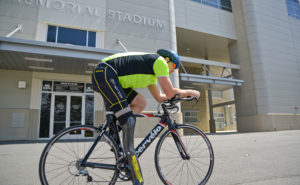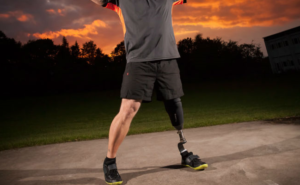Choosing prosthetic feet can significantly impact mobility and comfort. The right option supports walking, running, or hiking with ease. With so many choices available, selecting the best one can be challenging. From energy-return feet to microprocessor-controlled models, each type offers distinct benefits. We’ll break down the options, their advantages, and key factors to consider.
Key Takeaways:
- Types of Prosthetic Feet:
- Non-articulated feet (e.g., SACH foot) are sturdy but lack ankle movement.
- Articulated feet (single-axis & multi-axis) improve mobility but require more maintenance.
- Energy-return feet improve walking efficiency and reduce strain.
- Microprocessor feet adjust in real-time for better stability but need power and upkeep.
- Cost & Insurance Coverage:
- Prosthetic feet range from $5,000 to $50,000.
- Medicare covers 80% if deemed medically necessary; coverage varies by Medicaid and private insurance.
- Grants and financial aid programs can help with costs.
- Best for Active Users:
- Running feet use carbon fiber for energy return.
- Hiking feet offer multi-axis flexibility for rough terrain.
- Sports feet (e.g., basketball) prioritize shock absorption and agility.
- Prosthetic Technology:
- AI and robotic feet improve adaptability and reduce strain.
- Choosing a Prosthetic Foot:
- Alignment, customization, and adaptation affect overall comfort.
- Physical therapy plays an important role in improving mobility.

The Different Types of Prosthetic Feet
Choosing a prosthetic foot depends on personal needs and activity level. Some are simple and sturdy, while others closely mimic natural movement. Knowing the options makes it easier to find the right fit.
Non-articulated vs. Articulated Prosthetic Feet
Non-articulated feet do not move at the ankle. They are strong and require little upkeep. The Solid Ankle Cushioned Heel (SACH) foot is a common example. It absorbs shock when stepping but lacks flexibility. The elastic keel foot provides slightly more movement, making it helpful for uneven ground.
Articulated feet have ankle joints that allow movement. A single-axis foot moves up and down, improving stability. It works well for those needing extra balance but requires more maintenance. A multi-axis foot moves in multiple directions, making it better for uneven terrain, though it is heavier and more expensive.
Energy-Return Prosthetic Feet and Their Benefits
Energy-return prosthetic feet store force when stepping and release it during push-off. The dynamic-response foot adapts to different walking speeds and distances, giving a spring-like effect. This makes walking smoother and less tiring. Some designs include split toes for better balance.
These feet are useful for people who are physically active or need extra support to reduce strain on their natural limbs. Over time, they help prevent joint pain and discomfort.
Microprocessor-Controlled Prosthetic Feet
Microprocessor-controlled prosthetic feet contain small computers that adjust movement based on sensors. These sensors track steps and modify the ankle position in real time. This technology improves balance and makes walking feel more natural, particularly on stairs and uneven surfaces.
Some models connect to smartphone apps for adjustable settings. They require charging and regular upkeep and tend to be more expensive and heavier than other options.
Knowing how these choices affect movement and comfort helps with selecting the best prosthetic foot for daily life. The final decision should match individual activity levels, comfort needs, and financial considerations.
Costs and Insurance Coverage
Prosthetic foot prices vary widely. Basic models cost around $5,000, while advanced microprocessor-controlled feet can reach $50,000. Pricing depends on material, technology, and design. High-performance models, such as those for running or hiking, tend to cost more.
Understanding Insurance Coverage
Many private insurers, along with Medicare, provide partial coverage. Specifically, Medicare usually covers 80% of the cost if the prosthetic foot is deemed medically necessary. However, Medicaid coverage can vary significantly by state, creating potential confusion. Additionally, some private insurance plans may only pay for basic models, which means patients could be responsible for the cost of any upgrades.
Financial Assistance Options
For those lacking full coverage, financial aid is available. Organizations such as the Amputee Coalition offer grants or donated prosthetic feet. Veterans may receive full coverage through the VA. Some charities and nonprofits also provide prosthetics at reduced costs.
A prosthetist can help with insurance paperwork to improve approval chances. Since grants and aid applications can take time, it's best to start the process early. If you're considering a below-knee prosthetic, learn more about your options here.
The Best Prosthetic Feet for an Active Lifestyle
The right prosthetic foot makes high-impact activities easier. Whether running, hiking, or playing sports, choosing a foot with proper energy return and flexibility is key.
Running-Specific and High-Performance Prosthetic Feet
High-performance prosthetic feet use carbon fiber to store and release energy with each step. As a result, this improves efficiency and reduces strain. Furthermore, some models feature split toes to enhance balance on uneven ground.
A common choice among runners is the blade-style prosthetic foot. Its curved shape provides a natural push-off for greater speed. Consequently, sprinters and marathon runners may benefit from designs focused on high-speed movement. However, it is important to keep in mind that these models are not always ideal for daily wear.
Prosthetic Feet for Hiking and Outdoor Activities
Hikers need prosthetic feet with multi-directional flexibility. Some models shift in multiple ways, allowing traction on uneven surfaces.
Multi-axis prosthetic feet work well for steep inclines and rocky trails, adjusting quickly to changes in terrain. Some designs also absorb shock to minimize stress on the residual limb. Waterproof and durable materials help maintain performance in outdoor conditions.
Energy-Return Prosthetic Feet for High-Impact Sports
High-impact sports, such as basketball and tennis, require quick movements and reliable cushioning. A dynamic-response prosthetic foot, therefore, helps with takeoff and agility, storing and releasing energy efficiently.
Moreover, these features reduce joint stress and fatigue, making them a good choice for athletes who are active every day. Additionally, some models even include shock-absorbing components to protect against repetitive impact.
Ultimately, no single prosthetic foot suits every sport or activity. Thus, the best choice depends on individual goals. Consulting a prosthetist ensures the right selection.. For more on leg prosthetics, explore prosthetic leg variations and differences.
Prosthetic Foot Technology and User Experience
Microprocessor-controlled prosthetic feet adjust to movement in real time. Sensors track steps and relay information to a small computer, which modifies foot position and resistance. This feature makes walking on slopes, stairs, and uneven surfaces easier. Some models even link to smartphone apps for real-time customization.
AI-powered prosthetic feet use advanced algorithms to predict motion patterns. These models adjust faster than traditional microprocessor types and adapt to walking pace and terrain more naturally.
Robotic prosthetic feet go a step further by incorporating powered movement. Motors assist with push-off, reducing strain on the knees and hips. Some models help restore a more natural walking pattern.
Future developments will likely introduce lighter, more responsive designs with improved battery life and shock absorption. Advancements in these areas will make prosthetics more comfortable and efficient.
Things to Consider While Choosing a Prosthetic
The right prosthetic foot simplifies daily movement. Three main factors influence the selection: alignment, customization, and adaptation.
Proper Alignment and Fitting
A prosthetic foot must be correctly aligned with the rest of the leg. Good alignment improves balance, minimizes pressure points, and helps prevent joint pain. A prosthetist adjusts the foot’s angle for stability.
A test socket is often used before finalizing the design. This step helps achieve a secure and comfortable fit before crafting the permanent socket.
Customization Options
Different prosthetic feet offer unique features, such as shock-absorbing heels or adjustable ankle movement. For more active individuals, lightweight materials like carbon fiber improve flexibility and durability.
It's important to select a foot that aligns with daily activities. Basic options work for short-distance walking, while advanced models support high-impact movement.
Adjusting to a New Prosthetic Foot
Getting used to a prosthetic foot takes time. Initial discomfort is normal, but physical therapy strengthens muscles and improves stability.
Regular check-ups help make adjustments as needed. If pain or misalignment occurs, a prosthetist can refine the fit.
Selecting the right prosthetic foot depends on mobility goals, comfort preferences, and budget. A well-chosen foot improves confidence and overall movement.
Discover the Right Prosthetic Foot for Your Lifestyle
Choosing the right prosthetic foot can make all the difference in your mobility, comfort, and confidence. From energy-storing feet for active individuals to specialized designs for everyday use, there’s a prosthetic solution tailored to your unique needs. At Horton’s Orthotics & Prosthetics, we’re here to guide you every step of the way with compassionate care and expert support. Ready to learn more? Contact us today to schedule a consultation and explore your options.



